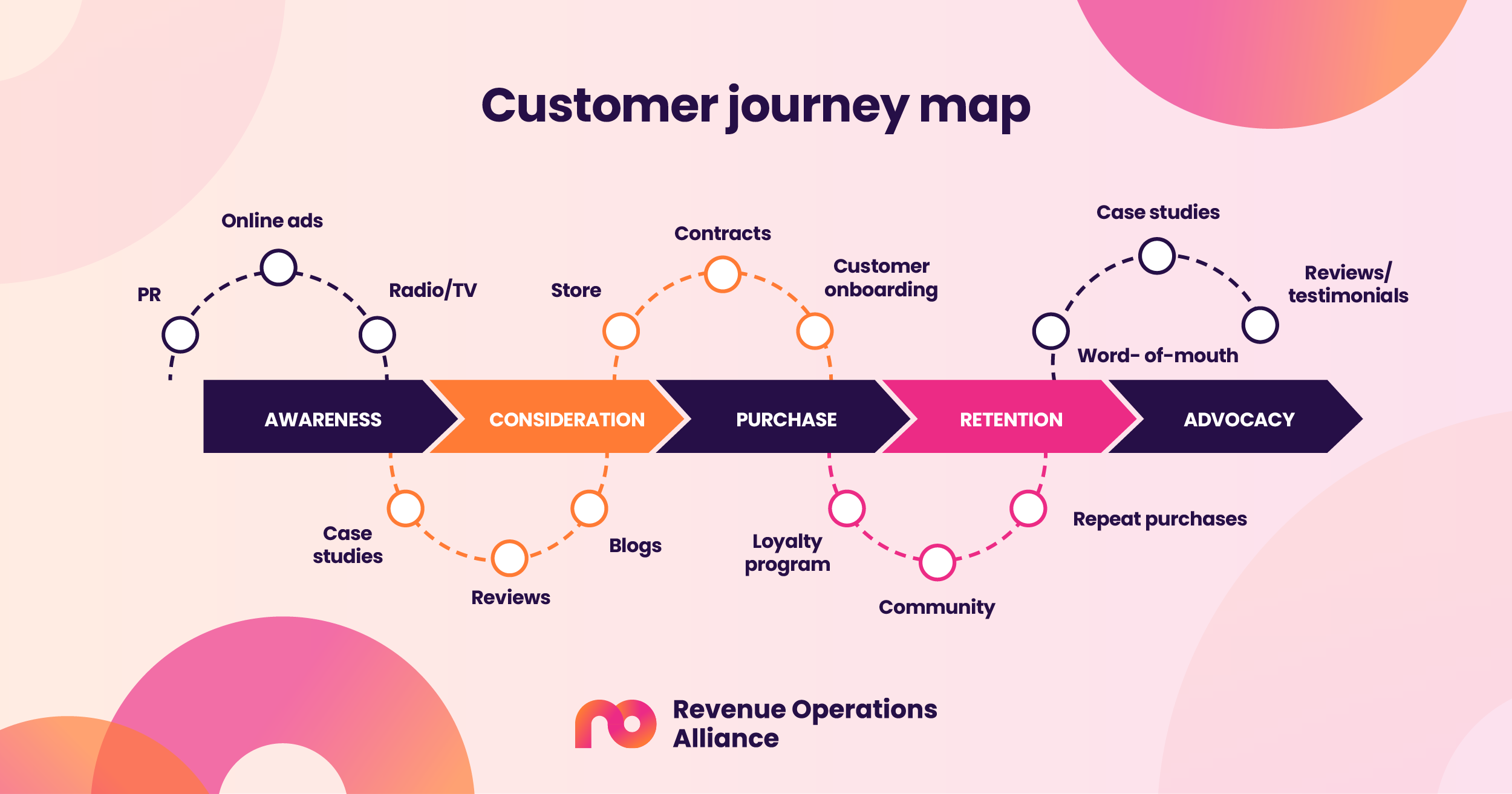Your customer journey is key to creating an excellent customer experience for your prospects. But it can also lead to high dropoff rates within your sales funnel if you aren’t careful.
An uncoordinated or frustrating customer journey means your customers are less likely to make it to purchase. Instead, they’ll turn to your competitors with a better customer experience.
The first step in optimizing your customer journey is to map it out. This allows visibility across your revenue function so your revenue operations strategy can better align your teams.
In this article we’ll cover:
- What a customer journey is
- Why customer journey maps are important in RevOps
- How to list key touchpoints
- How to create your customer journey map
- Communicating your customer journey internally
What is a customer journey?
A customer journey tracks the many touchpoints a customer interacts with pre- and post-purchase. Usually, a customer journey involves multiple stages: awareness, consideration, decision, purchase, and post-purchase. During each of these stages, your customers have different needs and preferences.
The B2B cycle can be even longer than this and span across multiple business units, making full-funnel visibility difficult. That’s where customer journey maps come in…

Why are customer journey maps important in RevOps?
Mapping this journey from awareness to post-purchase helps you understand your customers better. When you know the path your customers take to purchase, you can create smoother handoffs and transitions to reduce dropout rates.
If you can predict your customer’s next move, then you can meet them with the information they need at the right time and place. This will significantly improve your customer experience and lead to improved sales, and retention rates.
Visibility into the entire customer journey can highlight key transitions or touchpoints that require improvement. You may even discover an easy solution to a previously hidden revenue-draining problem.
Revenue operations professionals are in a unique position to oversee the creation of a customer journey map. Overseeing all revenue functions, marketing, sales, and customer success, allows RevOps teams visibility into all areas of the journey.
While sales, marketing, and customer success leaders may argue over whose fault a poor transition is, RevOps can take a birdseye view of the project and help to align the entire GTM function.

Benefits of customer journey mapping
Here are some additional benefits of mapping your customer journey:
- Competitive advantage over competitors with a poorer customer experience.
- Smooth customer journeys lead to happy customers, higher revenue, low churn rates, and positive word-of-mouth marketing.
- Understanding the weak points in your customer journey allows your teams to better exploit digital tools.
- Visibility into all aspects of the sales cycle allows resources to be allocated strategically to sales and marketing teams.
- Taking a customer-centric approach stimulates collaboration and alignment across your revenue function.

List key touchpoints
The first step to improving your customer journey is understanding it. But since B2B sales cycles are so complex, you should start with an exhaustive list and pare down from there.
This should be a collaborative process, so here are our best practices for brainstorming with other teams to create a complete customer touchpoint list.
Collaborate with revenue leadership
To start the process of building your customer journey map you have to trace your customer’s steps through your purchase cycle. Since revenue operations don’t solely own the customer journey, you should collaborate with the entire GTM function to start your research.
Reach out to sales, marketing, and customer success leadership and ask them to list every step in a customer’s journey. This will likely give you a long list of small steps a customer can take on the path from awareness to advocacy.
Hopefully, these steps will help you to see all the handoff points across your customer journey, helping you to identify potential friction points later on.

Ask your sales team
You may also want to ask your sales reps how they see the customer journey. The sales team is often the first human interaction customers have with your brand, so this team has a unique insight into the minds of your clients.
The sales team will also have insights into pain points your customers face during your customer journey, as well as common sticking points or drop-off points in the sales cycle.
These insights can help you to understand where your current customer journey needs improvements.
Go straight to the source
If you have the time and resources, you may also want to speak directly to your customers. Your buyers have already made their way through your customer journey, so will know what path they took to purchase, and which touchpoints weren’t up to standard.
Frame the conversation around wanting to improve the customer journey for current and future customers. Many buyers (or sales drop-outs) are likely to want to help out and detail their experiences.
The satisfaction of your current customers can also give you an indication of how well your buyer journey is currently performing.

Creating your customer journey map
Once you have your extra-long list of customer touchpoints you can work to reduce, and map them out into a usable resource. Start by creating a blueprint…
Create a blueprint
Creating a blueprint in a simple spreadsheet can help you to more clearly visualize how your customers progress through the buyer journey.
Each column should represent a stage in your customer journey. You can also split these stages into categories based on its stage in the general customer journey: awareness, consideration, decision, purchase, and post-purchase. This may help to keep things clearer.
In each row, you should detail information about each stage. Some examples of information to note down are:
- The goal of the stage. What do you want your customer to do next?
- Exit criteria. What will stop your customer from progressing?
- Advancement criteria. How will your customer move to the next stage? What transitions are involved?
- Internal actions. What actions must your reps take? What handoffs are required?
- External actions. What specific actions must the customer take?
- List any relevant objects, fields, and reports in your CRM. This will help you to identify what to look for in your database.
During this process, reduce touchpoints to the key stages they’re part of and consolidate similar steps in the journey. This will give you a solid blueprint to help with your implementation of improvements.
Ask GTM leadership for feedback
After you’ve drafted your blueprint you should seek more feedback from your GTM leadership in each department to ensure you’ve accurately described each stage in the customer journey. This also helps to ensure leadership are all on the same page.
This not only helps to quality check your work before releasing it internally, but this step also helps to gain buy-in from your sales, marketing, and customer success leaders, so they can champion any changes to follow.

Communicate customer journey across your organization
Once you’ve finalized your customer journey map, you can share it with your revenue teams using handouts. This will allow your teams to align around this journey and visualize the handoffs along the process.
You may want to provide an overview of the entire customer journey as well as separate pages focusing on each department’s responsibilities across the journey. Particular attention should be paid to areas where there’s a handoff between departments - the process for the transition should be detailed in communications.
Your revenue enablement team should help you train and educate your teams on this new resource and any new processes that arise from its implementation across your organization.

Final thoughts
Mapping your customer journey is an important step towards improving your customer experience across your sales cycle. While RevOps plays a big part in this process, a collaborative approach should be used to avoid missed touchpoints.
Overall a map of your customer journey can help to align your revenue teams and point out the issues within your organization’s processes. Thus guiding your revenue operations strategy.
Looking to connect with likeminded RevOps pros? Join our Slack community today. 👇






